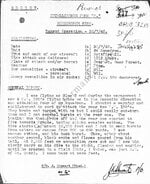wrathofatlantis
Airman
- 75
- Oct 2, 2023
I have to laugh at your P-51B Me 109G-6 above. The Bf 109 has a lower stall speed than the P-51B, and fights quite well at lower speeds. No self-respecting P-51B pilot would try to get SLOWER against a Bf 109 unless he was VERY fast to begin with. Best corner speed was about 270 mph IAS at 8,000 pounds and 10,000 feet (not many P-51 fights at 10,000 feet. Some, yes). It changed as you got heavier. By "best", I mean 8-g at the slowest speed where it can GET 8-g, meaning smallest radius of turn, at least for a part of a turn.
Nobody flew 75 - 100 turns in combat. Assume the pilot is flying a good fighter. His 360 degree turn is about 25 seconds give or take a bit. 75 turns would take half and hour or more. Right ...
Have you even looked at my post I wonder?
You know better than World War II Mustang Ace Clayton Kelly Gross, 355thFS, 354th FG, I presume?
View: https://youtu.be/wkaTGSpRuJI?si=Oolu80vxuQFWKXvD
AT THE 1:20 MARK "Fortunately, those shells went just behind my tail. I made I think probably 75 to 100 circles. Whether the Mustang was that much better (makes a small pinching gesture) or I was that much better than him, or a combination of both, I was gaining on him."
I already explained why a circle fight "locks you in." You cannot roll out.
Sustained speed was more like 23 seconds in my estimation, due to the reduced radius, so 3 full circles was roughly 69 seconds.
90 circles was thus around 34.5 minutes. On two other occasions other pilots stated "We flew in a circle for half an hour."
Quote "Nobody flew 75 - 100 turns in combat."
Tell that to Clayton gross then... I know of 3 examples, plus one shorter, all involving the P-51B vs the Me-109G-6. One is a P-51D.
While rare, it is not at all unknown.
As I pointed out, one Oscar survived 1/2 hour of gunnery passes by 16 P-38s until they all ran out of fuel and ammo. He escaped unharmed.
The Ki-43-II is less than 15 second to a circle. 30 minutes would be around 120 circles.
Quote from one P-38 pilot who saw this: "All he did was loafing in a circle at reduced power with his hood open."
The general conception of what WWII combat looked like is based either on the jet era or video games. Add to this a few German aces against isolated radioless receiver-only Soviet pilots, or P-38 aces against literally radio-less Zero pilots. (Apparently an effect of magnetic conditions in the South Pacific, affecting the Japanese Navy radios more: Justin Pyke devotes a good part of his interview to this.)
Hit and Run mostly worked on a straight moving unaware target. Turns ruined hit and run approaches, or allowed a head to head. That is why WWII combat often looked like this. Turning both protected you and trapped a target.
1945 FW-190A-8 ace commenting on a painting of his aircraft wings level: "Our wings were never level in combat. We turned continuously to one side. Outnumbered as we were by then (1945), it was the only way to survive."
-Notes by QAZ, "Aviation Decisive Battle Weapons" P. 164-165, "Unknown Sword" P. 86-89 (Me-109E-7 vs
Ki-27): Oblt. Losigkeit: "I think the Bf-109 can shoot when the Ki-27 tries [begins] to turn. [However] the Ki-27 often
turns, so I cannot dive on it."
-From Osprey "Ki-43 'Oscar' aces of World War 2": P.50: (Sgt Toshimi Ikezawa, Ki-43 ace) "I heard Major Eto
had refused delivery of the Ki-84.--- Hayate (Ki-84) pilots would simply drop the nose, and be off in a flash... They
could not avoid an attack if it came from above however, because of the Ki-84's poor rate of turn. (Ki-43-II 540
km/h, Ki-84 660 km/h)
I think we owe our survival to the Ki-43, as the Ki-84 would have left you in a mighty tight spot if you were
attacked from above by P-51s. ---Skilled (Spitfire Mk VIII) enemy pilots such as flight leaders would pull out of
their dives when they realized they could not catch us [unaware]. New pilots would dive straight down on us,
leaving them vulnerable in a turning fight." (Mk VIII: 650 km/h)
-Iseo Mochizuki (Ki-61 pilot ace, 2009 interview, 90 years old): "In the case of the Hien, you
would make a high speed attack [makes dive and zoom hand gesture]. But then, because [of
the speed] the turn radius became wide, and the enemy pilot [target] could turn inside you.
Because of that [speed] the chances of being shot down was high."
Last edited:

